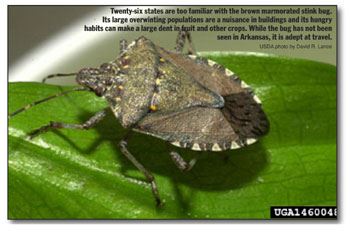Hitchhiking Stink Bug Could Find Way To Arkansas
LITTLE ROCK, ARK.
A highly mobile stink bug that’s causing
problems in 26 states could eventually
hitchhike its way to Arkansas, according to
the University of Arkansas Division of Agriculture.
The brown marmorated stink bug is native to
Asia, but it made the United States its home in
the 1990s when it hitched a ride to this country.
“This pest has spread quickly over several
states by hitching rides on various human
transportation,” said Scott Akin, assistant professor
and extension entomologist with the University
of Arkansas Cooperative Extension
Service. “They can utilize cars, trucks, trains
and other vehicles, and this could eventually
pose a threat to Arkansas row crops such as
soybean, and perhaps even corn and cotton.”

The brown marmorated stink bug has been
identified from Maine to North Carolina, as well
as Iowa and California. In the northeastern
U.S., these pests were initially reported as a
nuisance in homes and other buildings as they
overwintered, but as the population rapidly increased,
they caused damage to fruit and vegetable
crops the following growing season. Last
year, the insects caused localized losses of fruit
crops to fruit crops in some areas of the northeastern
U.S.
Akin said the brown marmorated stink bug
has a wide range of hosts on which to feed,
using piercing sucking mouthparts that damage
and kill fruit tissues.
Hosts include apples, peaches, citrus fruits,
figs, mulberries, persimmons, blackberry, wine
grapes, field corn, sweet corn, ornamental
plants, soybeans, tomatoes, lima beans and
green peppers as well as various trees, woody
shrubs and weeds.
Eggs of brown marmorated stink bugs are
barrel-shaped and similar to stink bug species
usually seen in Arkansas crops. The eggs are
light green or yellow to almost white in color,
tend to darken with age and are laid in groups
of 25 to 30. The yellowish red and black nymphs
are relatively easy to see, and their dark red
eyes are easily distinguishable on the black
head. The abdomen progresses to off-white with
reddish spots, and the legs, head and thorax of
the nymphs are black. Antennae have black
with white bands.
Adult brown marmorated stink bugs have a
shield-shaped body and are typically one-half to
five-eighths of an inch long. They can be hard to
see because of their mottled brown-grey color.
The most notable is that several abdominal segments
protrude from beneath the wings, resulting
in a black-and-white checkerboard-like
appearance on the edges of the abdomen. The
antenna has a white band on it, which easily
distinguishes this stink bug from other native
brown-colored stink bug species.
Stink bug species whose adults can be confused
for brown marmorated are the brown
stink bug and spined soldier bug. The brown
stink bug adult has almost no white and few abdominal
segments showing. The beneficial
spined soldier bug also can have easily-viewed
abdominal segments from above, but has little
white coloration as well as sharp points on the
shoulders.
If you find a stink bug and have questions
about its identity, bring a sample to your county
extension office. Δ